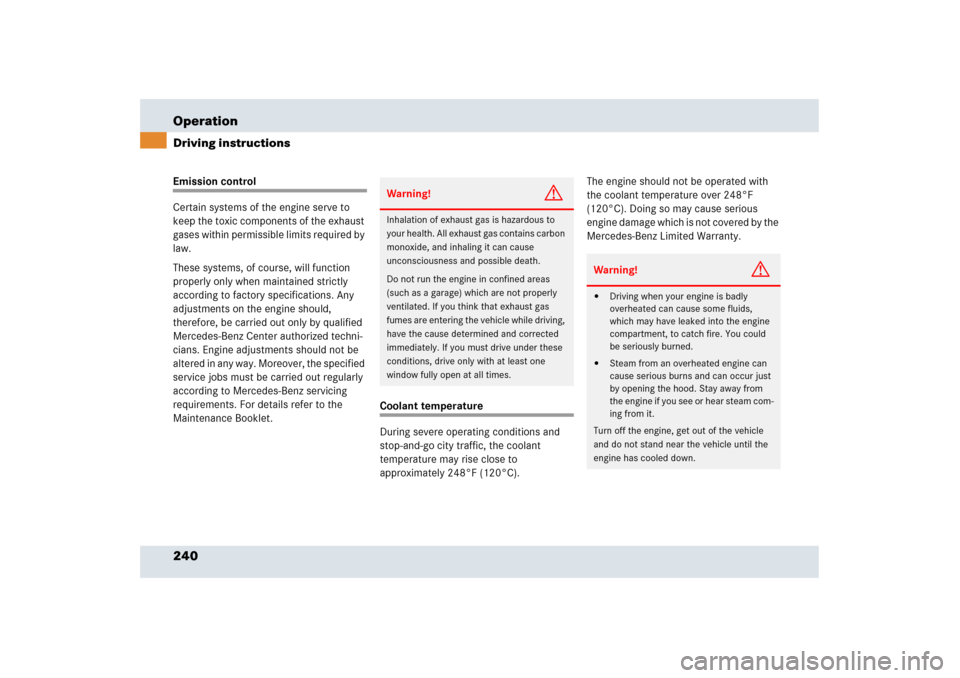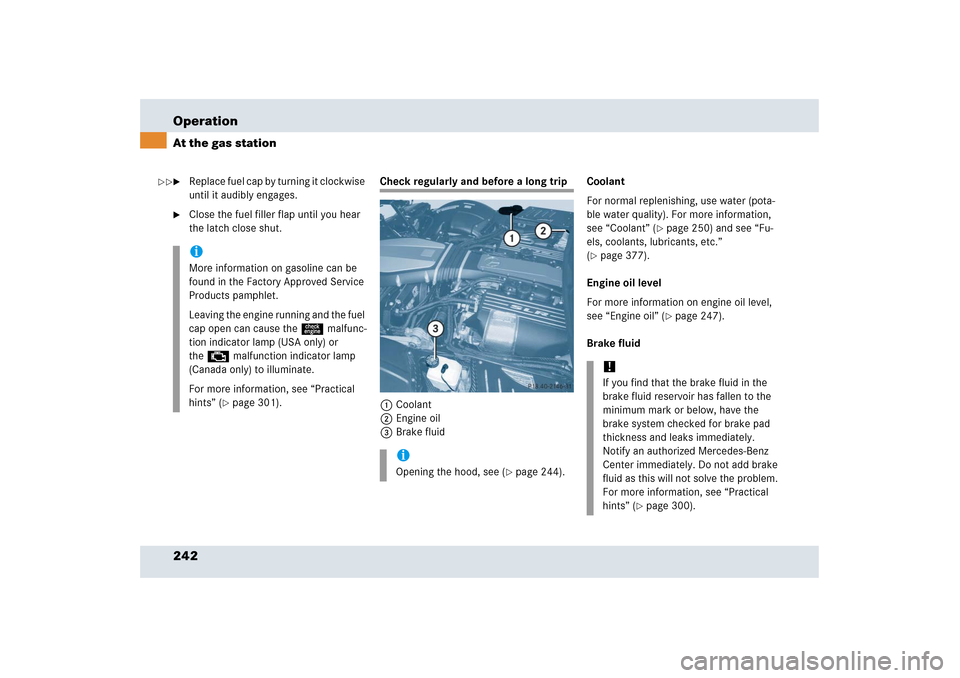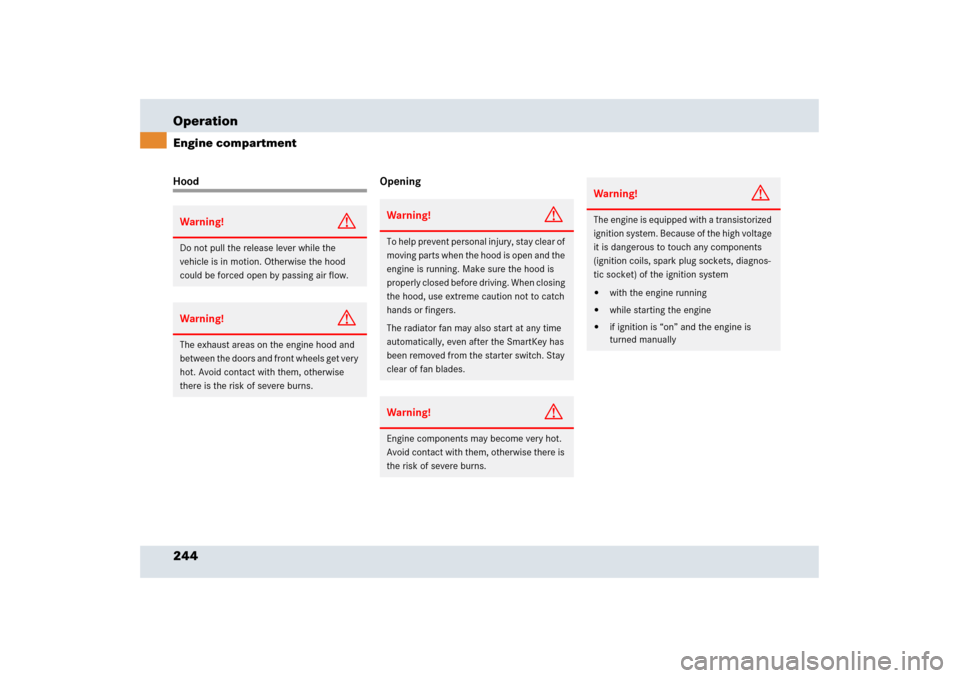Page 240 of 409

239 Operation
Driving instructions
Telephones and two-way radios
Radio transmitters, such as a portable
telephone or a citizens band unit should
only be used inside the vehicle if they are
connected to an antenna that is installed
on the outside of the vehicle.
Refer to the radio transmitter operation
instructions regarding use of an external
antenna.
Catalytic converter
Your Mercedes-Benz is equipped with
monolithic-type catalytic converters, an
important element in conjunction with the
oxygen sensors to achieve substantial
control of the pollutants in the exhaust
emissions. Keep your vehicle in proper
operating condition by following our
recommended maintenance instructions
as outlined in your Maintenance Booklet.
Warning!
G
Never operate radio transmitters equipped
with a built-in or attached antenna (i.e. with-
out being connected to an external antenna)
from inside the vehicle while the engine is
running. Doing so could lead to a malfunc-
tion of the vehicle’s electronic system,
possibly resulting in an accident and
personal injury.
!To prevent damage to the catalytic
converters, only use premium unleaded
gasoline in this vehicle.
Any noticeable irregularities in engine
operation should be repaired promptly.
Otherwise excessive unburned fuel
may reach the catalytic converter,
causing it to overheat and potentially
start a fire.
Warning!
G
As with any vehicle, do not idle, park or
operate this vehicle in areas where combus-
tible materials such as grass, hay or leaves
can come into contact with the hot exhaust
system, as these materials could be ignited
and cause a vehicle fire.Warning!
G
The exhaust areas on the engine hood and
between the doors and front wheels get very
hot. Avoid contact with them, otherwise
there is the risk of severe burns.
Page 241 of 409

240 OperationDriving instructionsEmission control
Certain systems of the engine serve to
keep the toxic components of the exhaust
gases within permissible limits required by
law.
These systems, of course, will function
properly only when maintained strictly
according to factory specifications. Any
adjustments on the engine should,
therefore, be carried out only by qualified
Mercedes-Benz Center authorized techni-
cians. Engine adjustments should not be
altered in any way. Moreover, the specified
service jobs must be carried out regularly
according to Mercedes-Benz servicing
requirements. For details refer to the
Maintenance Booklet.
Coolant temperature
During severe operating conditions and
stop-and-go city traffic, the coolant
temperature may rise close to
approximately 248°F (120°C).The engine should not be operated with
the coolant temperature over 248°F
(120°C). Doing so may cause serious
engine damage which is not covered by the
Mercedes-Benz Limited Warranty.Warning!
G
Inhalation of exhaust gas is hazardous to
your health. All exhaust gas contains carbon
monoxide, and inhaling it can cause
unconsciousness and possible death.
Do not run the engine in confined areas
(such as a garage) which are not properly
ventilated. If you think that exhaust gas
fumes are entering the vehicle while driving,
have the cause determined and corrected
immediately. If you must drive under these
conditions, drive only with at least one
window fully open at all times.
Warning!
G
�
Driving when your engine is badly
overheated can cause some fluids,
which may have leaked into the engine
compartment, to catch fire. You could
be seriously burned.
�
Steam from an overheated engine can
cause serious burns and can occur just
by opening the hood. Stay away from
the engine if you see or hear steam com-
ing from it.
Turn off the engine, get out of the vehicle
and do not stand near the vehicle until the
engine has cooled down.
Page 243 of 409

242 OperationAt the gas station�
Replace fuel cap by turning it clockwise
until it audibly engages.
�
Close the fuel filler flap until you hear
the latch close shut.
Check regularly and before a long trip
1Coolant
2Engine oil
3Brake fluidCoolant
For normal replenishing, use water (pota-
ble water quality). For more information,
see “Coolant” (
�page 250) and see “Fu-
els, coolants, lubricants, etc.”
(
�page 377).
Engine oil level
For more information on engine oil level,
see “Engine oil” (
�page 247).
Brake fluid
iMore information on gasoline can be
found in the Factory Approved Service
Products pamphlet.
Leaving the engine running and the fuel
cap open can cause theú malfunc-
tion indicator lamp (USA only) or
the± malfunction indicator lamp
(Canada only) to illuminate.
For more information, see “Practical
hints” (
�page 301).
iOpening the hood, see (
�page 244).
!If you find that the brake fluid in the
brake fluid reservoir has fallen to the
minimum mark or below, have the
brake system checked for brake pad
thickness and leaks immediately.
Notify an authorized Mercedes-Benz
Center immediately. Do not add brake
fluid as this will not solve the problem.
For more information, see “Practical
hints” (
�page 300).
��
Page 245 of 409

244 OperationEngine compartmentHood OpeningWarning!
G
Do not pull the release lever while the
vehicle is in motion. Otherwise the hood
could be forced open by passing air flow.Warning!
G
The exhaust areas on the engine hood and
between the doors and front wheels get very
hot. Avoid contact with them, otherwise
there is the risk of severe burns.
Warning!
G
To help prevent personal injury, stay clear of
moving parts when the hood is open and the
engine is running. Make sure the hood is
properly closed before driving. When closing
the hood, use extreme caution not to catch
hands or fingers.
The radiator fan may also start at any time
automatically, even after the SmartKey has
been removed from the starter switch. Stay
clear of fan blades.Warning!
G
Engine components may become very hot.
Avoid contact with them, otherwise there is
the risk of severe burns.
Warning!
G
The engine is equipped with a transistorized
ignition system. Because of the high voltage
it is dangerous to touch any components
(ignition coils, spark plug sockets, diagnos-
tic socket) of the ignition system�
with the engine running
�
while starting the engine
�
if ignition is “on” and the engine is
turned manually
Page 246 of 409
245 Operation
Engine compartment
The release lever is located in the driver's
footwell.
1Release leverThe hood folding mechanism is disengaged
in two stages.
�
Pull release lever1 downwards.
This completes the first stage.
!Make sure the windshield wipers are
not folded away from the windshield.
Otherwise the windshield wipers or the
hood could be damaged.
Make sure there is sufficient clearance
before opening the hood. A minimum
clearance in front of the vehicle of 3/4ft (25 cm) is required.
iIf it was not possible to release the
hood, pull the release lever downwards
more firmly.
Page 247 of 409
246 OperationEngine compartment2Hood latch
The hood latches are located in the upper
air intake next to the headlamp units. �
Pull the hood latches2.
This completes the second stage.
�
Pull the hood towards you to the stop.
�
Press the front part of the hood.
The hood opens and will automatically
be held in position by gas-filled spring
struts.!Make sure there is sufficient clearance
before opening the hood. A minimum
overhead clearance of 6.6 ft (2.0 m) is
required.
Page 248 of 409

247 Operation
Engine compartment
Closing�
Pull the hood upwards in the center,
against the resistance of the gas-filled
spring struts.
�
Hold the front center part of the hood
with both hands and push it back-
wards. After pushing the hood back-
wards about half-way, you will feel the
hood passing a crest and the resulting
force pulling the hood away from you.
At that point, let go of the hood and let
it fall onto the latches.
The hood should now be locked and en-
tirely closed.
�
Check that the hood is properly closed.
If the hood is not properly engaged, re-
peat the closing procedure.
Engine oil
The amount of oil your engine needs will
depend on a number of factors, including
driving style. Higher oil consumption can
occur when�
the vehicle is new
�
the vehicle is driven frequently at
higher engine speeds
Engine oil consumption checks should only
be made after the vehicle break-in period.
Oil consumption of the SLR is slightly high-
er than other vehicles. Please check the
engine oil level frequently.
Warning!
G
Be careful that you do not close the hood on
anyone.
!Make sure the rollers at the rear of the
hood are engaged and the guide pins
line up with the guide holes. Otherwise
the hood may be damaged.
!Do not use any special lubricant addi-
tives, as these may damage the drive
assemblies. Using special additives not
approved by Mercedes-Benz may
cause damage not covered by the
Mercedes-Benz Limited Warranty.
Page 249 of 409
248 OperationEngine compartmentChecking the engine oil level
When checking the oil level,�
the vehicle must be parked on level
ground
�
the engine must be at normal operating
temperature (min. 80°C)
�
Wait for at least 30 seconds with
engine still at idle.
�
Measure engine oil level with engine
still at idle.The dipstick and the cap are located on the
passenger side in the engine compart-
ment.
1Dipstick
2Filler cap
�
Pull out dipstick1 and wipe it off.
�
Reinsert the dipstick fully into the
guide.
�
Pull out the dipstick again after
3 seconds.
DipstickThe engine oil level must be between the
lower (min) and upper (max) marks.�
Top up the engine oil if necessary.iThe difference in level between the up-
per and lower marks represents a
volume of about 2.1 US qt (2.0 l).